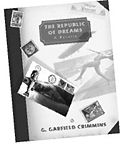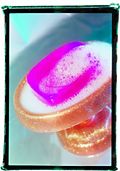AT THE MOMENT, the Showbox ballroom is a mess. Most everything is covered in plastic sheeting, the sound of drills is coming from every direction, and the smell of paint is overwhelming.
Planet Stiff
Showbox, opens July 2
Wading through the chaos, Franklin Joyce is helping me envision how things will look when the Planet Stiff festival opens on July 2. “We’ll have three large screens,” he says. “One of them will be over there.” He gestures toward two columns. Where the other two screens will be is as yet unclear. He’s moved on now to telling me about the rotunda, where there will be four smaller, rice-paper screens, two horizontal and two vertical, on which will be projected images and floating text relating to what’s showing on the large screens—a kind of visual emcee for the evening.
What is this hybrid of video, music, and performance art? How can I describe what Joyce and fellow festival producer Roderick Hatfield call a “high-tech, deep-groove, multi-screened, polyphonic film fest”? That these questions are not readily answerable is attributable to the impulses driving Planet Stiff. “The idea,” Hatfield says, “is to bring otherwise isolated arts together to create innovative work that shatters boundaries.” In other words, to create something beyond definition. And where there is no explanation, there are no expectations. The audience helps to create the Planet Stiff experience.
Planet Stiff was inspired about three years ago when Hatfield attended the Sundance Film Festival in Park City, Utah. He discovered a simultaneous festival, called “slumdance,” held in what he describes as an “underground ghetto” where the alternative, experimental films were being shown. It was clearly a reaction to the mainstreaming of Sundance—and of indie films in general—as well as to the expense of staying in a place like Park City in order to see the so-called cutting edge of film.
Hatfield decided to create a similar festival in Seattle, one that would exist in opposition—not antagonistically but rather playfully—to the Seattle International Film Festival. The first two Planet Stiffs (the name is derived from SIFF) were, Hatfield says, “guerrilla warehouse events”; this year, however, Planet Stiff is separating itself from SIFF and working on a more sophisticated technological scale, with more projectors, more performers, and more complicated space.
To put the festival together, Hatfield and Joyce—both of them earnest and very modest young men with extensive connections in various Seattle art scenes—sat down and imagined an evening of peak experience, listing various filmmakers, bands, and installation and performance artists they wanted to invite. The producers next sent out invitations and then created a Planet Stiff program, pairing music and performance, video and art, from the list of artists who accepted. The festival’s centerpiece consists of three different half-hour screenings of the best shorts from local curated festivals by—among others—911 Media Arts, Independent Exposure, 3-Dollar Bill, and WigglyWorld. These, Joyce explains, will be rear-projected onto the big screens, which will be set up so the viewer can either sit behind a screen and focus on the work or mill around in front of it, combining viewing of the videos with a more social experience.
BETWEEN THE main screenings will be a dazzling mix of music and performance; for example, the performance troupe Magna Vox, wearing primitive, mythic animal masks by artist Roger Wheeler, will be combined with the music of the Broun Fellinis, who blend Coltrane- and Monk-like sounds with hip hop—all against a video background. Hatfield is particularly thrilled by the inclusion of the Harry Smith Archives. The late Smith, a poet and avant-garde filmmaker greatly admired by Allen Ginsberg and Bob Dylan, left an extraordinary collection of films: hand-painted color-burststyle animation that references his interest in alchemical symbols, the occult, ethnography, and cosmography. The color and style of his work, much of which was done in the 1940s, prefigures the psychedelia of the ’60s, and recognition of his influence on film and music as well as painting is only just beginning to surface.
Butoh artist d.K. Pan will wear a conical video-screen dress, onto which video images will be projected, creating a piece of clothing whose texture and pattern change from moment to moment. Artist and designer HPX created both the dress and the video, and the performance will be accompanied by Skerik and Om, a saxophone player and a diva, respectively, with music that not even the producers have been allowed to hear.
This last surprise seems to typify the experience that Planet Stiff will provide—one that can’t be imagined or described until it’s actually happening. The event emerges and takes form out of the pieces that individual performers provide, combined with the element of the ballroom’s space, the imaginative drive of the producers, and the collective mind and interaction of the audience. The round shape of the ballroom by necessity makes the event a multifocal one, letting the viewer take a certain amount of responsibility for creating his or her own experience. “We don’t want to compel the audience,” Hatfield says. “We want to seduce it.” Planet Stiff strives to engender “a movement,” he adds, “toward an intuitive relationship with art.”
While the lineup of performers seems overwhelming, Hatfield insists that the festival is “not a blitz on the senses. It’s a carefully orchestrated evening of sound and image. It should have a dramatic crescendo, a quickening pace that compels the audience through a series of epiphanies, toward a cathartic movement. It will be an elegant unfolding. We hope.” He grins. “Perhaps a series of cathartic moments, with denouements in between. The point is to get people out of the dark, out of the silence of the usual movie experience, out of the theater grid.”






